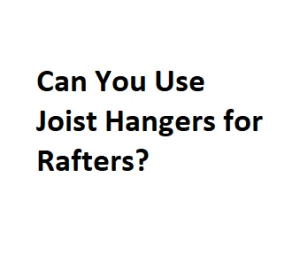Understanding Joist Hangers:
Rafters vs. Joists:
Compatibility of Joist Hangers for Rafters:
Factors to Consider:
- Load Capacity: Evaluate the load capacity of the selected joist hangers. Ensure they can handle loads on rafters, including roofing materials and extras like snow.
- Size and Type of Joist Hangers: Choose joist hangers that are appropriately sized for the rafters and designed for vertical applications. Consider using heavy-duty or adjustable hangers for increased strength and flexibility.
- Building Codes and Regulations: Always adhere to local building codes and regulations.
- Environmental Factors: Consider the climate and environmental conditions of the building site. Different weather elements may expose rafters, requiring joist hangers to resist corrosion and other environmental factors.
Installation Considerations:
When using joist hangers for rafters, proper installation is paramount to ensure their effectiveness. Follow these installation considerations for a secure and reliable roofing structure:
- Orientation: Install the joist hangers with the correct orientation. Ensure that the flanges align flush against the supporting structure, and drive the nails or screws through the designated holes to preserve the hanger’s load-bearing capacity.
- Nail or Screw Selection: Use the recommended nails or screws specified by the manufacturer. Ensure they are corrosion-resistant, especially if the roof is exposed to outdoor elements. The right fasteners will contribute to the overall stability and longevity of the structure.
- Spacing and Layout: Follow the spacing and layout guidelines provided by the manufacturer. Proper spacing helps distribute the load evenly and prevents structural issues. Consider factors such as rafter size, pitch, and local building codes when determining the spacing.
- Structural Engineering Input: If in doubt or dealing with a complex roof design, seek the advice of a structural engineer. They can evaluate your project’s requirements and advise on the suitable application of joist hangers for rafters.
- Regular Inspections: After installation, conduct regular inspections to ensure the joist hangers remain in good condition. Check for signs of wear, corrosion, or any structural issues that may compromise the integrity of the roof.
Alternatives to Joist Hangers:
Consider the following options:
- Rafter Ties: Rafter ties connect opposing rafters near the roof’s bottom, preventing spreading. They are a traditional and effective method for stabilizing the roof structure.
- Collar Ties: Install collar ties higher up on the rafters to help prevent the roof from sagging. Similar to rafter ties, collar ties are horizontal members that contribute stability to the roof.
- Metal Connectors for Rafters: Some manufacturers produce metal connectors designed explicitly for rafters. Engineers design these connectors to handle the unique loads and forces experienced by roof structures


